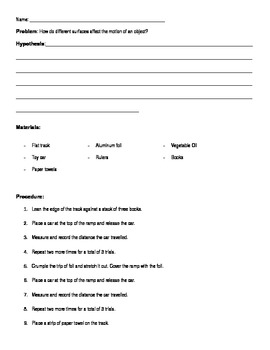We just finished our Force and Motion Unit. This is one of my favorites to teach for many reasons. It's really easy to make it all hands on and the kids LOVE it! My post today is really a Throwback post since we did this WEEKS ago, but I just came across my pictures and remembered how much fun it was! We have an old kit with many pieces missing. However, we have all of the plastic toy car track.
To start with, as a whole class, we went over our problem, materials and the procedures that we would go through.
Problem: How do different surfaces effect the motion of an object?
Materials: Flat track, Toy Car, Aluminum Foil, Vegetable Oil (I used Pam spray - it was easier), Meter Stick (because Scientists use the Metric System - except I only have 1 Meter stick so we measure with yard sticks), Paper Towels, Crates or Books.
Then, we discussed what a good hypothesis looks like before students wrote their own.
 |
| Click on the image to get your copy of the experiment! |
Next, we split into groups of 3-4 students. I had already set up stations throughout the classroom. Since I didn't want the groups to be too big for the experiment, I added a computer station and a "just for fun" station.
1. Plain Track (control)
2. Vegetable Oil Track
3. Paper Towel Track
4. Aluminum Foil Track
5. Plain Track on the carpet (just for fun)
After everyone went through all of the stations, students used calculators to find the averages. They then created triple bar graphs showing the movement of their cars (I wish I had take a picture of one of them - they were SO GOOD!). Last but not least, they answered their conclusion questions.
I loved having the stations set up in Science! It gave us a different format to follow and kept the students moving and engaged.
What other experiments do you do during your Force and Motion unit?
Labels: Force and Motion, Science, Stations

